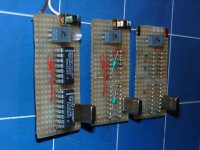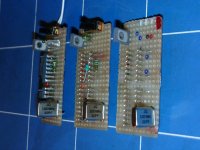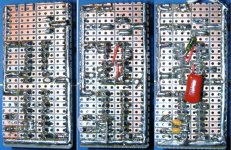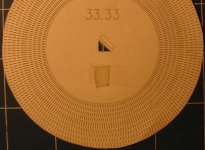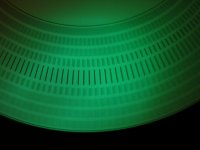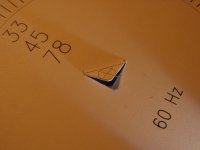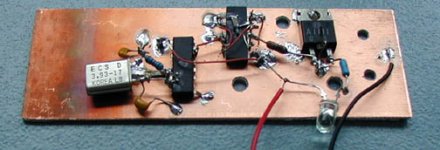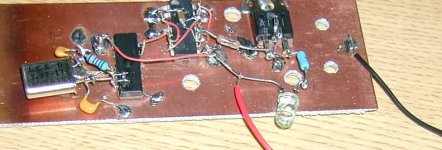And this is how the strobe flasher and strobe disc look like on operation.
Photo taken during the night with several seconds of shutter time. Nevertheless the bar pattern of the wide ring is sharp and stable (even more in real life) The slight blurriness comes from my shaky hand holding the flasher and from printer-generated lack o centricity/run.
Photo taken during the night with several seconds of shutter time. Nevertheless the bar pattern of the wide ring is sharp and stable (even more in real life) The slight blurriness comes from my shaky hand holding the flasher and from printer-generated lack o centricity/run.
Attachments
All,
from the pixes you should be able to get this lil'circuit running fine; i built 4 units already, to look if design is rugged and can be copied. All 4 run fine.
I have used an expensive 11cd green LED; the strobscope still works if the place is flooded with elerctric light.
Should there be a problem to get the 3.93216 MHz crystal or the ultrabriught LED, i can provide them at cost. Should any of you feel uncomfartable with building this circuit, he maybe can talk me into building one but this service will not be for free.
Write me an email with any QQ. Or post them here.
from the pixes you should be able to get this lil'circuit running fine; i built 4 units already, to look if design is rugged and can be copied. All 4 run fine.
I have used an expensive 11cd green LED; the strobscope still works if the place is flooded with elerctric light.
Should there be a problem to get the 3.93216 MHz crystal or the ultrabriught LED, i can provide them at cost. Should any of you feel uncomfartable with building this circuit, he maybe can talk me into building one but this service will not be for free.
Write me an email with any QQ. Or post them here.
Bernhard,
This looks like a fun little project.
It turns out the parts are pretty easy to get from Digikey, which is a US parts distributor that will handle small orders.
Here are the part numbers:
Digikey # Price
3.93216Mhz crystal X013-ND $0.64
4060 CD4060BE $0.84
4013 CD4013BE $0.48
The other parts are very standard and I probably don't need to list their stock numbers. Just go to
http://www.digikey.com/
They have a reasonable search function which makes it easy to find what you need.
As usual, I have no connection with Digikey, other than as a satisfied customer. Those of us in the US don't have many local suppliers, so places like Digikey are what keeps us going.
---Gary
This looks like a fun little project.
It turns out the parts are pretty easy to get from Digikey, which is a US parts distributor that will handle small orders.
Here are the part numbers:
Digikey # Price
3.93216Mhz crystal X013-ND $0.64
4060 CD4060BE $0.84
4013 CD4013BE $0.48
The other parts are very standard and I probably don't need to list their stock numbers. Just go to
http://www.digikey.com/
They have a reasonable search function which makes it easy to find what you need.
As usual, I have no connection with Digikey, other than as a satisfied customer. Those of us in the US don't have many local suppliers, so places like Digikey are what keeps us going.
---Gary
Just wondering (this is a subject I know very little about ). I have two batteries and a recharger left from a passed away cordless drill. They are 12V when fully charged. Could they be used successfully to power the Maxon motors? Would there be an advantage in doing so (I keep reading that battery supplies are superior) or does it only add extra complications.
). I have two batteries and a recharger left from a passed away cordless drill. They are 12V when fully charged. Could they be used successfully to power the Maxon motors? Would there be an advantage in doing so (I keep reading that battery supplies are superior) or does it only add extra complications.
If so how would one go about that?
 ). I have two batteries and a recharger left from a passed away cordless drill. They are 12V when fully charged. Could they be used successfully to power the Maxon motors? Would there be an advantage in doing so (I keep reading that battery supplies are superior) or does it only add extra complications.
). I have two batteries and a recharger left from a passed away cordless drill. They are 12V when fully charged. Could they be used successfully to power the Maxon motors? Would there be an advantage in doing so (I keep reading that battery supplies are superior) or does it only add extra complications. If so how would one go about that?

Peterr,
of course, you can use the batteries. Provided the motor (at 78rpm if you want) gets its voltage and the series regulator also gets its voltage drop.
How you keep them charged is quite another matter. A reliably working battery charge is quite some effort and the batteries are used in series during operation but should be charged connected in parallel or even separated by any means. Having batteries charged as battery pack (connected in series) is inherently unreliable. Just a Q of time until the weakest cell slowly kills the other cells and renders the pack unusable. But if NiCd or NiMH are charged properly, they reach the 1000x recharging. Without problems.
You also can do it like i do it for my 1st try:
Transformer, Graetz bridge made from discrete Schottky recitifiers, filter: LC, then some LT1086 or LM317 or even 78 S 12 (15, 18) as pre-reg and an L200 as adjustable 2nd reg. Quite paranoid to have a pre-reg **and** a choke input filter, but it has been reported that a pre-reg is audible and andvantageous sonically. I am going to find that out.
The choke input filter serves another purpose: it does create such a constant load for the recitifer that the rectifier does not shoot back nasty spikes into into the power line and mess up your preamp's or CDP's sonics by stirring up their power supply.
For the same reason, i use only superfast Schottky rectifiers (or TV damper diodes for tube amps) and choke input filter where ever possible, because then no device messes up the others. Learned that from my buddies Manfred and Peter.
If you give me a few days time, i see that i try it out myself; then i post the schematic you asked for. OK?
of course, you can use the batteries. Provided the motor (at 78rpm if you want) gets its voltage and the series regulator also gets its voltage drop.
How you keep them charged is quite another matter. A reliably working battery charge is quite some effort and the batteries are used in series during operation but should be charged connected in parallel or even separated by any means. Having batteries charged as battery pack (connected in series) is inherently unreliable. Just a Q of time until the weakest cell slowly kills the other cells and renders the pack unusable. But if NiCd or NiMH are charged properly, they reach the 1000x recharging. Without problems.
You also can do it like i do it for my 1st try:
Transformer, Graetz bridge made from discrete Schottky recitifiers, filter: LC, then some LT1086 or LM317 or even 78 S 12 (15, 18) as pre-reg and an L200 as adjustable 2nd reg. Quite paranoid to have a pre-reg **and** a choke input filter, but it has been reported that a pre-reg is audible and andvantageous sonically. I am going to find that out.
The choke input filter serves another purpose: it does create such a constant load for the recitifer that the rectifier does not shoot back nasty spikes into into the power line and mess up your preamp's or CDP's sonics by stirring up their power supply.
For the same reason, i use only superfast Schottky rectifiers (or TV damper diodes for tube amps) and choke input filter where ever possible, because then no device messes up the others. Learned that from my buddies Manfred and Peter.
If you give me a few days time, i see that i try it out myself; then i post the schematic you asked for. OK?
Just lost my reply 
 . I try again
. I try again
 .
.
It is not that I am all set on using them. More I was wondering if this was an easy solution that could be used by me and others as well. I mean everybody should have a broken cordless drill these days...

 . I try again
. I try againAs these batteries are from a (professional) cordless drill they come with a specific charger. And because you have two batteries you use one and charge the other. The have been recharged many times and my guess is they will recharge a few times moreHow you keep them charged is quite another matter. A reliably working battery charge is quite some effort and the batteries are used in series during operation but should be charged connected in parallel or even separated by any means. Having batteries charged as battery pack (connected in series) is inherently unreliable.
It is not that I am all set on using them. More I was wondering if this was an easy solution that could be used by me and others as well. I mean everybody should have a broken cordless drill these days...
Of courseIf you give me a few days time, i see that i try it out myself; then i post the schematic you asked for. OK?
peterr,
you may have re-charged your cordless drill bacteria pack 30x, 50x, maybe 100x, okok.
A decent set of NiCd or NiMH bacteria makes 1000x re-charging.
I have opened bacteria sets of video cameras, cordless tools, what ever, 1 out 20 had a charging supervision processor in them, the rest was just made as i made by bacteria pack for the bicycle, have them all in series. And i recharged my packas about 100x maximum, some 30x, and then they had lost almost all their capacity. Why? because one cell dies 1st and takes care by this that the other cells get discharged deeper than healthy for them. Which makes them die sooner than expected too.
Would i be to make me a battery pack today, i would use a 8 or 10pin connector and have each cell connected to 2 pins. The opposite plug bridges this to series connection for use/discharge and to parallel or even separate for cheap ... Amphenol Mate N-Lok does fine here.
Or i wold use a battery holder and standard rechargeables and a commercial processor battery charger.
you may have re-charged your cordless drill bacteria pack 30x, 50x, maybe 100x, okok.
A decent set of NiCd or NiMH bacteria makes 1000x re-charging.
I have opened bacteria sets of video cameras, cordless tools, what ever, 1 out 20 had a charging supervision processor in them, the rest was just made as i made by bacteria pack for the bicycle, have them all in series. And i recharged my packas about 100x maximum, some 30x, and then they had lost almost all their capacity. Why? because one cell dies 1st and takes care by this that the other cells get discharged deeper than healthy for them. Which makes them die sooner than expected too.
Would i be to make me a battery pack today, i would use a 8 or 10pin connector and have each cell connected to 2 pins. The opposite plug bridges this to series connection for use/discharge and to parallel or even separate for cheap ... Amphenol Mate N-Lok does fine here.
Or i wold use a battery holder and standard rechargeables and a commercial processor battery charger.
Bernhard,
I slapped one of these little strobes together and it works fine. I guess my LEDs aren't as bright as yours, so I found the short pulse width to give marginal brightness. Changing the 5nf cap to a 0.1uf cap gave a longer pulse and brightened things up nicely.
I've attached a few pictures showing the construction and the end result on my turntable.
My construction is much cruder than yours. I just flipped the chips over "bug style" and soldered parts directly using a copper clad board as the ground reference. I used mainly SMD parts to keep things relatively neat. I substituted a 2SA1111 transistor for yours since I had that handy and as I mentioned, I changed the 5nf cap to 0.1uf. The holes you see will be used to mount a battery holder on the other side of the board. I haven't decided upon the final case, if any.
Thanks again for the neat little project.
---Gary
I slapped one of these little strobes together and it works fine. I guess my LEDs aren't as bright as yours, so I found the short pulse width to give marginal brightness. Changing the 5nf cap to a 0.1uf cap gave a longer pulse and brightened things up nicely.
I've attached a few pictures showing the construction and the end result on my turntable.
My construction is much cruder than yours. I just flipped the chips over "bug style" and soldered parts directly using a copper clad board as the ground reference. I used mainly SMD parts to keep things relatively neat. I substituted a 2SA1111 transistor for yours since I had that handy and as I mentioned, I changed the 5nf cap to 0.1uf. The holes you see will be used to mount a battery holder on the other side of the board. I haven't decided upon the final case, if any.
Thanks again for the neat little project.
---Gary
Attachments
Gary,
good work! See you get your hands on one of those bright LEDs, of you do not find them, i may have one for you when we soon meet.
The short duty cycle is vital not for precision but for the good contrast. I compared my thingie to the one Thomas Scheu sells. Vastly better as Scheu's one has 50% duty cycle...
good work! See you get your hands on one of those bright LEDs, of you do not find them, i may have one for you when we soon meet.
The short duty cycle is vital not for precision but for the good contrast. I compared my thingie to the one Thomas Scheu sells. Vastly better as Scheu's one has 50% duty cycle...
Bernhard,
Thanks for the kind words.
I think you are definitely right about a brighter LED with a shorter duty cycle being a good idea.
In your original design the RC is about 0.2msec. Assuming it takes 3 RC to trigger things, then the LED should be on for 0.6msec. The pulse - pulse duration is 1/120 = 8.3msec. Thus the strobe is only on about 7% of the time. If anything, on the scope the pulse looks even shorter than this.
With the bigger capacitor you approach closer to a 50% duty ratio. On the scope it looks more like 30%-40%, but it definitely doesn't "freeze" time as well as a short pulse. I can definitely notice the strobe pattern wobbling due to an off center mounting hole on my strobe disk. I suspect I'd see less of this with the shorter pulses.
Still, the strobe works very well even with the longer pulses and I can adjust speed without difficulty.
Regards,
---Gary
Thanks for the kind words.
I think you are definitely right about a brighter LED with a shorter duty cycle being a good idea.
In your original design the RC is about 0.2msec. Assuming it takes 3 RC to trigger things, then the LED should be on for 0.6msec. The pulse - pulse duration is 1/120 = 8.3msec. Thus the strobe is only on about 7% of the time. If anything, on the scope the pulse looks even shorter than this.
With the bigger capacitor you approach closer to a 50% duty ratio. On the scope it looks more like 30%-40%, but it definitely doesn't "freeze" time as well as a short pulse. I can definitely notice the strobe pattern wobbling due to an off center mounting hole on my strobe disk. I suspect I'd see less of this with the shorter pulses.
Still, the strobe works very well even with the longer pulses and I can adjust speed without difficulty.
Regards,
---Gary
- Status
- This old topic is closed. If you want to reopen this topic, contact a moderator using the "Report Post" button.
- Home
- Source & Line
- Analogue Source
- DIY TT: motor, motor PS, platter speed measurements
